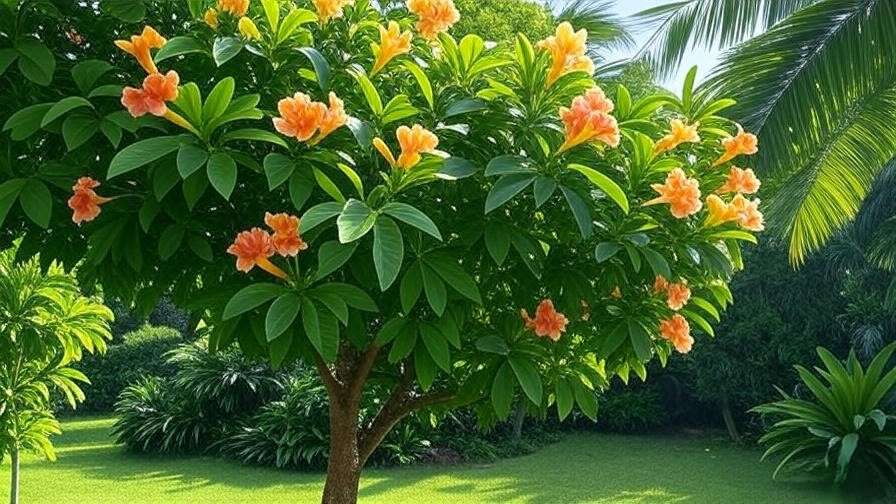Imagine stepping into your garden and being greeted by a cascade of vibrant, trumpet-shaped flowers swaying gently in the breeze. That’s the magic of a Bignoniaceae tree, a stunning addition to any landscape that brings tropical flair and ecological benefits. Whether you’re dreaming of the purple blooms of a Jacaranda or the golden trumpets of a Tabebuia, these trees are showstoppers that elevate your outdoor space. But how do you ensure your Bignoniaceae tree thrives? In this comprehensive guide, we’ll walk you through expert-backed tips on planting, caring for, and troubleshooting these ornamental trees to achieve vibrant blooms and robust health. Drawing on decades of horticultural expertise and insights from certified arborists, this article is your roadmap to growing a flourishing Bignoniaceae tree that becomes the centerpiece of your garden. 🌿
H2: What is a Bignoniaceae Tree? 🌿
H3: Overview of the Bignoniaceae Family
The Bignoniaceae family, often called the trumpet-vine family, is a group of trees, shrubs, and vines known for their eye-catching, tubular flowers and lush foliage. These plants are native to tropical and subtropical regions, with many species thriving in warm climates across the Americas, Africa, and Asia. Popular Bignoniaceae trees include the Jacaranda (Jacaranda mimosifolia), Trumpet Tree (Tabebuia spp.), and Catalpa (Catalpa spp.), each prized for its ornamental qualities. Their flowers, ranging from purple to yellow to pink, attract pollinators like bees and hummingbirds, making them both beautiful and ecologically valuable.
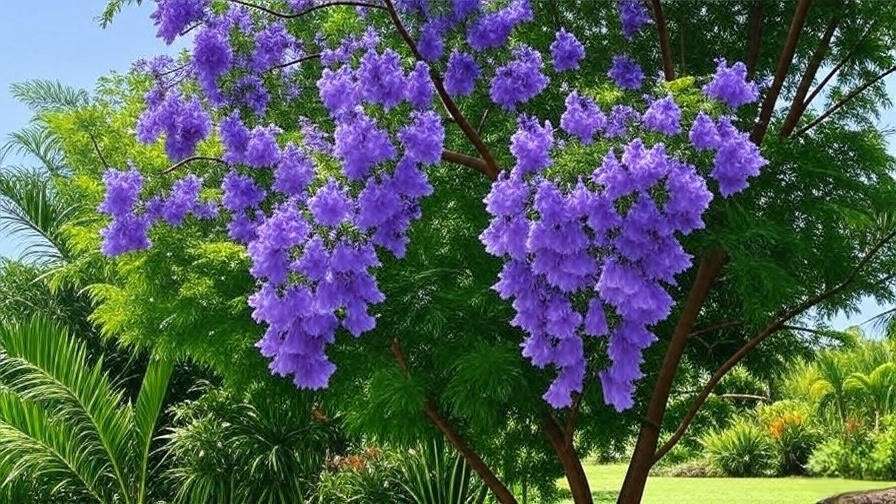
H3: Why Choose a Bignoniaceae Tree for Your Garden?
Bignoniaceae trees are a gardener’s dream, offering a blend of aesthetic appeal and practical benefits. Their vibrant blooms create a tropical ambiance, perfect for Mediterranean or coastal-inspired landscapes. Beyond beauty, these trees provide shade, reduce energy costs by cooling homes, and support local wildlife. For example, a homeowner in Southern California transformed their backyard into a pollinator haven by planting a Jacaranda, which now attracts hummingbirds annually. Whether you’re enhancing curb appeal or creating a backyard oasis, a Bignoniaceae tree delivers unmatched charm and functionality. 🌞
H2: Selecting the Right Bignoniaceae Tree for Your Space 🌞
H3: Factors to Consider Before Planting
Choosing the perfect Bignoniaceae tree starts with understanding your environment. Most species thrive in USDA hardiness zones 8-11, preferring warm climates with mild winters. Consider your available space: a Jacaranda can grow up to 40 feet tall with a wide canopy, while Tabebuia varieties are more compact, ideal for smaller yards. Soil type matters too—Bignoniaceae trees prefer well-drained, slightly acidic to neutral soil (pH 6.0-7.5). Full sun exposure is non-negotiable for vibrant blooms, so select a planting site with at least 6-8 hours of direct sunlight daily.
H3: Top Bignoniaceae Species for Home Gardens
Here’s a quick guide to popular Bignoniaceae trees:
- Jacaranda mimosifolia: Famous for its lavender-purple flowers, this tree is a showpiece for large spaces, growing 25-40 feet tall. Blooms in spring, creating a carpet of petals.
- Tabebuia spp. (Trumpet Tree): Compact (15-25 feet), with yellow, pink, or white flowers. Perfect for smaller gardens or patios.
- Catalpa spp.: Known for heart-shaped leaves and clusters of white or yellow flowers, growing 20-50 feet depending on the variety.
| Species | Height | Bloom Color | Best For |
|---|---|---|---|
| Jacaranda mimosifolia | 25-40 ft | Purple | Large yards |
| Tabebuia spp. | 15-25 ft | Yellow/Pink | Small gardens, patios |
| Catalpa spp. | 20-50 ft | White/Yellow | Mixed landscapes |
Tip: Check your local nursery for region-specific varieties to ensure compatibility with your climate.
H2: Planting Your Bignoniaceae Tree: Step-by-Step Guide 🌱
H3: When and Where to Plant
The best time to plant a Bignoniaceae tree is early spring or fall, allowing roots to establish before extreme heat or cold. Choose a site with full sun and ample space to accommodate the tree’s mature size. Avoid planting near structures, as some species, like Jacaranda, have expansive root systems that can damage foundations. Test your soil’s pH and drainage—amend clay-heavy soils with compost or sand to improve drainage.
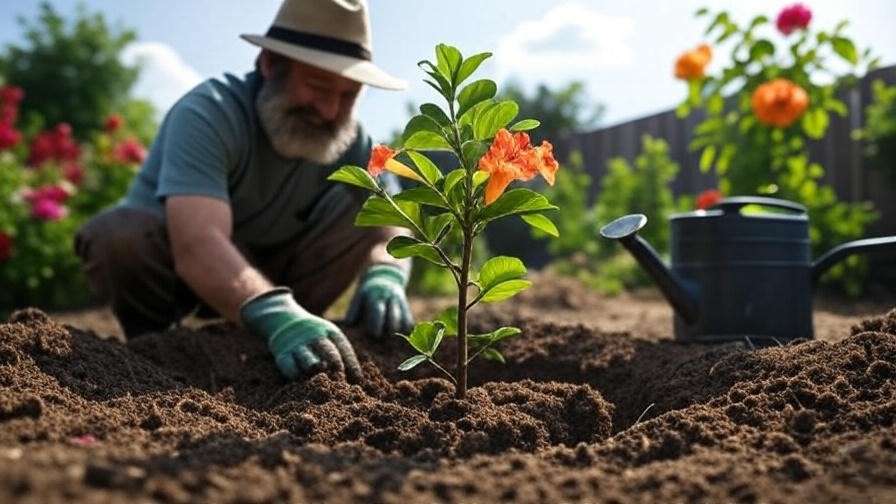
H3: How to Plant Properly
Follow these steps for successful planting:
- Dig the hole: Make it twice as wide and as deep as the root ball.
- Prepare the root ball: Gently loosen roots to encourage outward growth.
- Place the tree: Set the tree in the hole, ensuring the top of the root ball is level with the ground.
- Backfill: Fill with a mix of native soil and organic compost, tamping down lightly.
- Water thoroughly: Soak the soil to settle roots, but avoid waterlogging.
Expert Insight: “One common mistake is planting too deeply, which suffocates roots,” says Dr. Maria Lopez, a certified arborist with 20 years of experience in tropical tree care. “Always ensure the root flare is visible above the soil.”
H2: Essential Care Tips for Healthy Bignoniaceae Trees 🌼
H3: Watering Requirements
Young Bignoniaceae trees need consistent moisture to establish strong roots. Water 1-2 times per week, providing 1-2 inches of water, depending on rainfall. Mature trees are more drought-tolerant but benefit from deep watering during prolonged dry spells. Use a soaker hose or drip irrigation to deliver water directly to the root zone, minimizing waste. Tip: Check soil moisture by digging 2 inches down—if it’s dry, it’s time to water.
H3: Fertilizing for Optimal Growth
Fertilize your Bignoniaceae tree with a balanced, slow-release fertilizer (e.g., 10-10-10 NPK) in early spring and mid-summer. Apply according to package instructions, typically 1 pound per inch of trunk diameter. Avoid over-fertilizing, which can lead to excessive foliage at the expense of blooms or cause leaf burn. For flowering boost, use a phosphorus-rich fertilizer (e.g., 5-10-5) during the blooming season.
H3: Pruning and Maintenance
Prune your Bignoniaceae tree in late winter or early spring before new growth begins. Focus on:
- Removing dead or damaged branches.
- Shaping the canopy for structural integrity and airflow.
- Thinning crowded branches to reduce disease risk.
For Jacaranda, maintain a single leader trunk for the first few years to encourage upward growth. Example: A yearly pruning schedule for a Jacaranda might include light trimming in February to remove suckers and a more thorough shaping in March to enhance bloom production.
H3: Mulching and Soil Care
Apply a 2-3 inch layer of organic mulch (e.g., wood chips or bark) around the base of your tree, keeping it 2 inches away from the trunk to prevent rot. Mulch retains moisture, regulates soil temperature, and suppresses weeds. Replenish mulch annually to maintain its benefits. Periodically test soil pH and add amendments like sulfur or lime if needed to keep it in the 6.0-7.5 range.
H2: Common Problems and Solutions for Bignoniaceae Trees 🐛
H3: Pests and Diseases
Bignoniaceae trees are generally hardy but can face pest and disease challenges. Common pests include:
- Aphids: Small sap-sucking insects that cause leaf curling. Control with neem oil or insecticidal soap.
- Scale insects: Hard, shell-like pests that weaken branches. Remove with a soft brush or apply horticultural oil.
- Spider mites: Tiny pests causing stippled leaves. Increase humidity and use miticides if severe.
Diseases to watch for include:
- Root rot: Caused by overwatering or poor drainage. Ensure well-drained soil and avoid waterlogging.
- Powdery mildew: A white coating on leaves, treatable with fungicides or improved air circulation.
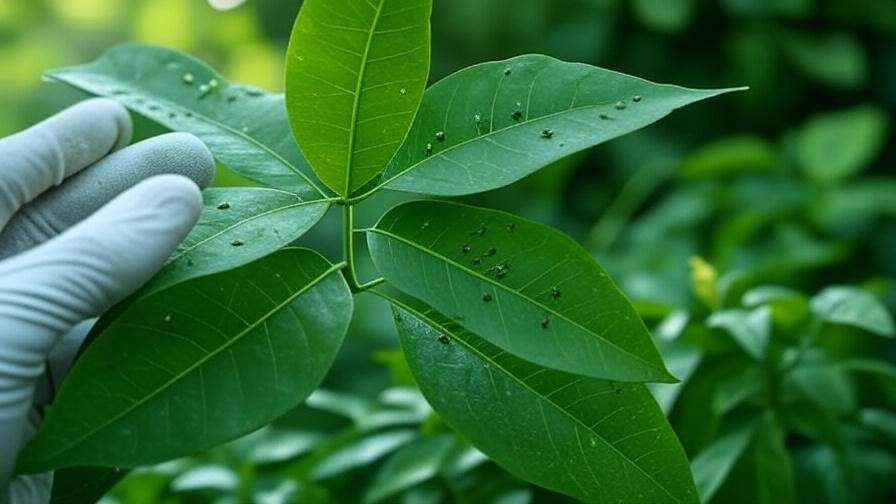
Solution: Regularly inspect your tree for early signs of trouble, such as discolored leaves or sticky residue. “Early detection is key,” says Dr. Maria Lopez, our arborist expert. “Catching pests or diseases early can save your tree from serious damage.”
H3: Environmental Stressors
Environmental factors can stress Bignoniaceae trees, leading to symptoms like yellowing leaves, wilting, or stunted growth. Common stressors include:
- Drought: Insufficient water causes leaf drop. Ensure deep watering during dry periods.
- Poor drainage: Soggy soil suffocates roots. Amend clay soils with sand or compost.
- Extreme heat: Prolonged heatwaves can scorch leaves. Provide temporary shade for young trees.
Diagnostic Checklist:
- Yellow leaves: Check for overwatering, underwatering, or nutrient deficiency.
- Wilting: Inspect for root rot or inadequate irrigation.
- Stunted growth: Test soil for nutrient imbalances or compaction.
Tip: If unsure, consult a local extension service or arborist for a professional diagnosis tailored to your region.
H2: Seasonal Care Tips for Year-Round Beauty 🍂
H3: Spring and Summer Care
Spring and summer are peak growth seasons for Bignoniaceae trees, making them critical for care:
- Watering: Maintain consistent moisture for young trees, especially during heatwaves.
- Fertilizing: Apply a phosphorus-rich fertilizer (e.g., 5-10-5) in spring to boost blooming.
- Pest monitoring: Check weekly for aphids or spider mites, as warm weather encourages infestations.
Encourage vibrant blooms by deadheading spent flowers on species like Tabebuia, which can promote a second flush of blooms in favorable conditions.
H3: Fall and Winter Care
As Bignoniaceae trees enter dormancy, adjust care to prepare for cooler months:
- Reduce watering: Water sparingly, as trees require less moisture in dormancy.
- Avoid late pruning: Pruning in fall can stimulate new growth vulnerable to frost.
- Frost protection: For young trees in cooler zones (e.g., USDA zone 8), wrap trunks with burlap or use frost blankets during cold snaps.
Example: In regions with mild winters, a Catalpa may retain some leaves, but reduce watering to prevent root rot during wet seasons.
H2: Enhancing Your Garden with Bignoniaceae Trees 🌴
H3: Companion Planting Ideas
Bignoniaceae trees pair beautifully with low-growing perennials that complement their bold aesthetic:
- Lavender: Adds fragrance and attracts pollinators, thriving in similar sunny conditions.
- Salvia: Vibrant flowers enhance the tropical vibe and support hummingbirds.
- Daylilies: Low-maintenance and colorful, they fill space beneath the tree’s canopy.
Avoid planting near aggressive root systems, like those of willows, to prevent competition for water and nutrients. Tip: Create a layered garden bed with perennials to enhance visual depth while maintaining soil health.
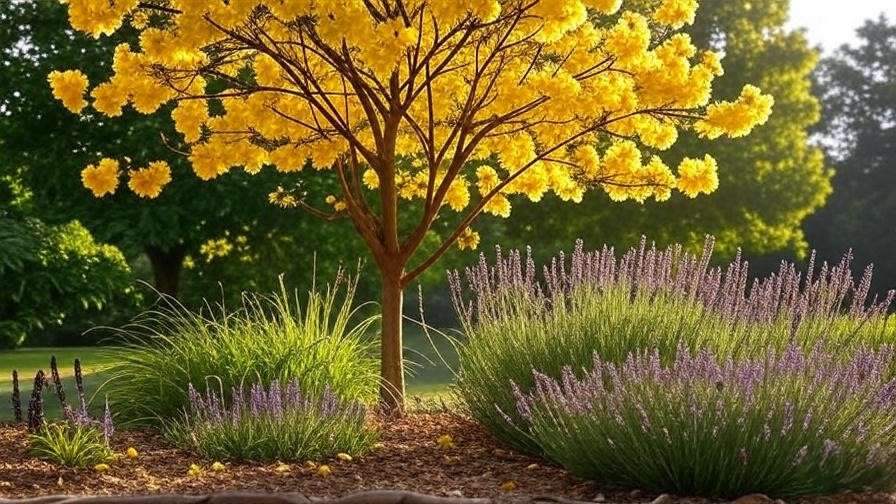
H3: Landscaping Inspiration
Bignoniaceae trees shine as focal points in various garden styles:
- Tropical oasis: Plant a Tabebuia near a patio with palms and ferns for a resort-like feel.
- Mediterranean courtyard: Pair a Jacaranda with gravel paths and drought-tolerant shrubs for elegance.
- Urban garden: Use a compact Catalpa as a street tree for shade and curb appeal.
For inspiration, consider sourcing high-quality stock photos from reputable sites like Shutterstock or Unsplash to visualize these designs (ensure proper licensing for commercial use). A well-placed Bignoniaceae tree can transform any space into a vibrant, inviting retreat.
H2: Environmental and Ecological Benefits of Bignoniaceae Trees 🌍
Bignoniaceae trees are more than just pretty—they’re ecological powerhouses. Their flowers attract pollinators like bees, butterflies, and hummingbirds, supporting biodiversity. A 2021 study from the University of Florida’s Institute of Food and Agricultural Sciences found that Jacaranda trees significantly increase pollinator activity in urban gardens, boosting local ecosystems. Additionally, their broad canopies provide shade, reducing home cooling costs by up to 20%, according to the U.S. Department of Energy. These trees also sequester carbon, contributing to climate change mitigation. By planting a Bignoniaceae tree, you’re investing in both beauty and sustainability.
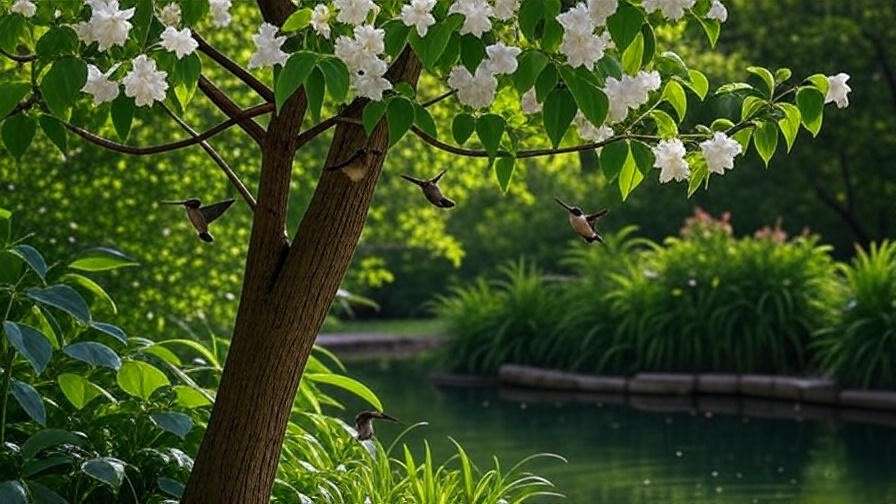
H2: FAQs About Bignoniaceae Tree Care ❓
Q1: How fast do Bignoniaceae trees grow?
A: Growth rates vary by species. Jacarandas grow moderately fast (1-2 feet per year), while Tabebuias are slower, reaching maturity in 5-7 years under ideal conditions.
Q2: Can I grow a Bignoniaceae tree in a container?
A: Smaller species like Tabebuia can be grown in large containers, but they require excellent drainage and regular pruning to control size. Jacarandas are less suited for pots due to their expansive roots.
Q3: What should I do if my tree isn’t blooming?
A: Lack of blooms may stem from insufficient sunlight, nutrient deficiencies, or improper pruning. Ensure full sun, apply a phosphorus-rich fertilizer, and avoid heavy pruning during bloom season.
Q4: Are Bignoniaceae trees invasive?
A: Most Bignoniaceae trees, like Jacaranda and Tabebuia, are non-invasive in well-managed gardens. However, check local regulations, as some species (e.g., Trumpet Vine) can spread aggressively in certain regions.
Conclusion: Transform Your Garden with a Thriving Bignoniaceae Tree 🌟
Growing a Bignoniaceae tree is a rewarding journey that brings vibrant blooms, ecological benefits, and timeless beauty to your garden. By selecting the right species, planting with care, and following expert-backed maintenance tips, you can ensure your tree thrives for years to come. Whether you’re drawn to the lavender cascades of a Jacaranda or the sunny trumpets of a Tabebuia, these trees are a testament to nature’s artistry. Start your Bignoniaceae journey today, and share your progress in the comments below! For more plant care inspiration, explore our guides on tropical tree care or attracting pollinators to your garden.

